The Best Plants for Hedges: 23 Types of Hedges (With Pictures)

Planting hedge bushes, shrubs, or trees in gardens add more than just aesthetic value. Many types of evergreen hedge shrubs create natural living privacy screens that block out noise, wind, and prying eyes. Other types of deciduous flowering hedge plants can line backyards with beautiful colors and scents when the hedge blooms. You can also grow hedge plants along walls, fences, or even in the front of house to create striking curb appeal.
The Best Hedging Plants
Some of the best plants for hedges are:
- Rose of Sharon (Hibiscus syriacus)—These bushy shrubs are beautiful hedging plants with dramatic, showy flowers when they bloom. An excellent plant for summer privacy screens.
- American Arborvitae (Thuja occidentalis ‘Smaragd’)—This arborvitae cultivar is a popular evergreen conifer for dense privacy hedging. The soft foliage and upright, compact growth make Thujas common in residential gardens.
- Common Holly (Ilex aquifolium)—This plant is a popular security and privacy hedge. Holly plants have shiny, evergreen foliage made of spiky leaves. Flowering in the summer before producing red berries in the winter adds color to yards throughout most of the year.
- European Beech (Fagus sylvatica)—Beech trees are fast-growing deciduous trees that can be clipped into formal hedges. The green foliage gives way to beautiful copper and red colors in the fall.
- Hedge Maple (Acer campestre)—This flowering maple plant is a trendy hedging tree with rapid growth. This species can grow together with other hedge bushes to create dramatic informal box-shaped hedges.
The Best Evergreen Hedging Plants (With Pictures and Names)
Evergreen hedges provide living privacy screens throughout the year. Many conifers are excellent choices as they have soft, dense foliage that provides protective natural barriers in your yard. Also, some broadleaf evergreen plants are fast-growing, and you can trim them into formal hedgerows.
Here is a list of the best hedge plants you can grow in your backyard and front of house.
Boxwood Hedge Plant (Buxus sempervirens)
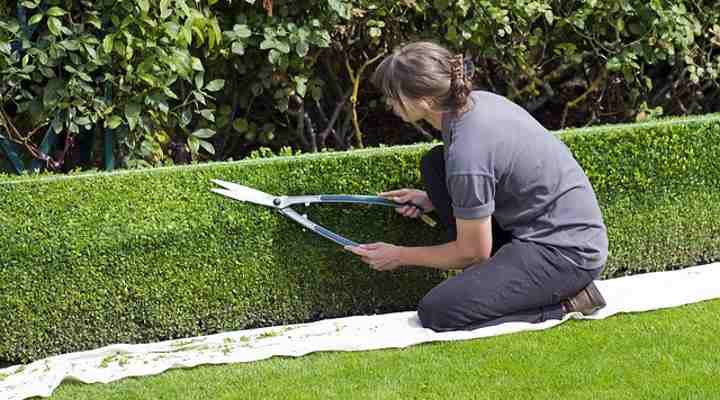
Box is a popular evergreen plant for creating formal hedges in your backyard or front of house
The compact growth of evergreen boxwood plants and its small leaves make the plant perfect for clipped, formal hedges. These hedge bushes are easy to prune and shape. And, as their common name suggests, they’re excellent for creating box-shaped privacy screens for year-round protection. Depending on the boxwood cultivar, hedges can grow to between 3 and 30 ft. (1 – 9 m)
The cultivar Buxus sempervirens ‘Suffruticosa’ is a dwarf hedging plant. The slow-growing, evergreen shrub is ideal for a low hedge that is between 2 and 3 ft. (0.6 – 1 m) tall. Boxwood shrubs are easy to shape if you want to improve curb appeal in a front yard.
American Arborvitae (Thuja occidentalis ‘Smaragd’) — Evergreen Hedge
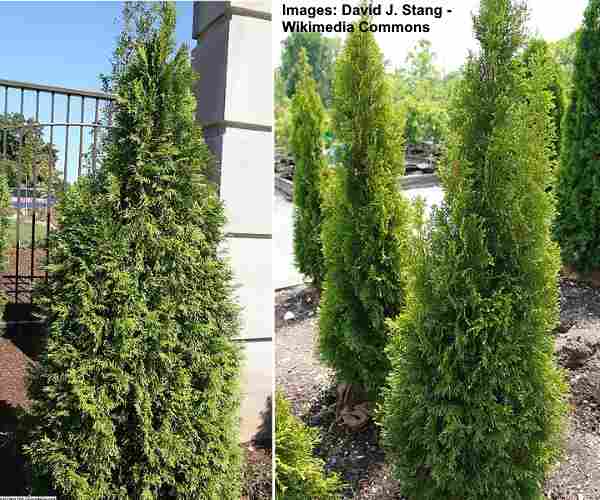
Pictures of thuja ’emerald green’ (‘Smaragd’) – it’s considered as one of the best evergreen trees for privacy. It’s also one of the most beautiful types of columnar trees.
Species of arborvitae create some of the best privacy hedges for garden landscapes. The ‘Smaragd’—also named ‘Emerald Green’—is a conical evergreen tree with upright growth. These hedging trees keep their shape without any maintenance. Growing up to 14 ft. (4 m) tall, regular pruning helps to control its height.
Grow arborvitae plants as a natural privacy barrier in backyards to keep our wind, noise, and snooping neighbors. Or, you can plant in front yards as a specimen tree to improve your home’s curb appeal.
Other suitable thuja plants for hedging include:
- Thuja standishii x plicata ‘Green Giant’—A fast-growing conical-shaped tree that is excellent for privacy screens or evergreen hedges.
- Thuja occidentalis ‘Filips Magic Moment’—This golden-yellow evergreen tree with its erect, dense, columnar growth is perfect for bright, informal hedgerows.
Cherry Laurel (Prunus laurocerasus)
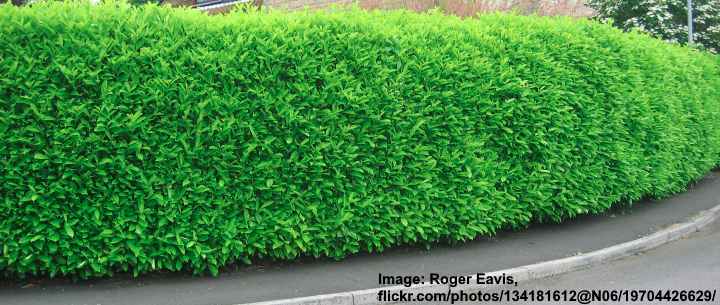
Cherry Laurel is a great fast growing evergreen shrub for privacy hedge
The attractive features of cherry laurel as an evergreen hedge are its broad leafy foliage and pretty white flowers. Cherry laurel hedge plants have a dense, bushy growth habit that creates an ideal privacy screen or windbreak. Plant in your yard in full sun wherever you need a tall informal hedge that flowers in the summer.
This hedging shrub grows to between 15 to 30 ft. (4 – 12 m). Regular pruning will help maintain the height you need.
Holly Hedge Bushes (Ilex)
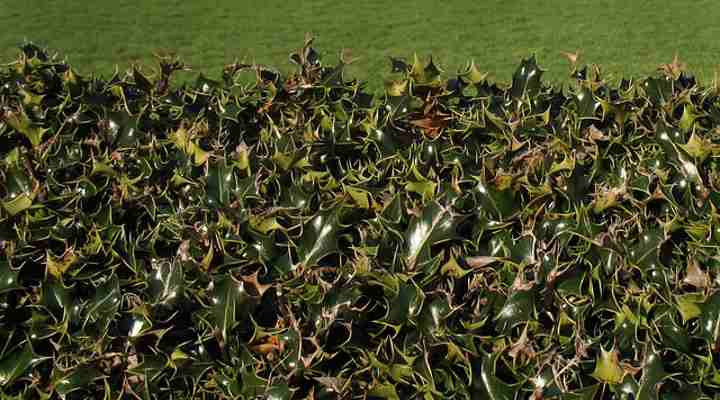
Holly bushes are common low-maintenance choice if you want evergreen hedge in your front or back yard
Holly plants are big hedge bushes that create effective privacy screens that also add some security. Most species of holly plants have jagged, stiff leaves that deter animals and intruders. Holly shrubs have a neat, compact growth that is ideal for narrow hedgerows.
Some holly bushes have variegated leaves if you want to create a bright spiky hedge in your yard. Suitable plants in the genus Ilex include:
- Alaska Holly (Ilex aquifolium ‘Alaska’)
- Dragon Lady Holly (Ilex × aquipernyi ‘Meschick’)
- Sky Pencil Holly (Ilex crenata ‘Sky Pencil’)
- Dwarf Yaupon Holly (Ilex vomitoria ‘Nana’)
Californian Privet (Ligustrum ovalifolium)
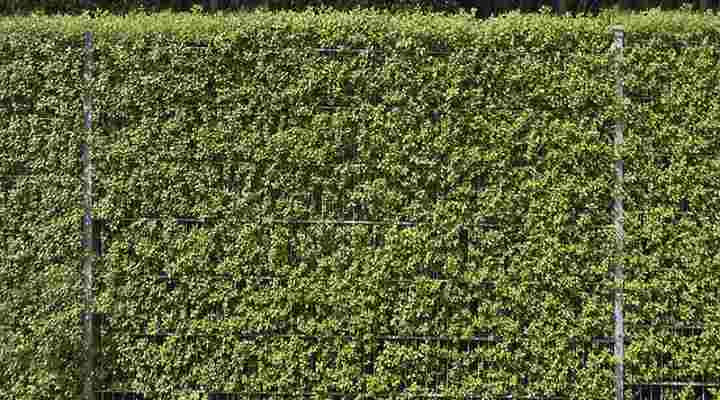
Choose privet shrubs if you want a fast growing privacy hedge
Privet is another plant species with many cultivars that are excellent for evergreen formal privacy hedges. The reason why privet plants are some of the best types of hedge bushes is due to their dense, fast-growing foliage. These clipped hedges can be formal or informal, and they require regular pruning during the growing season to keep their shape.
These tall hedge plants can grow to between 10 and 15 ft. (3 – 4.5 m). The common privet (Ligustrum vulgare) is another species of privet that is popular for privacy screening.
Japanese Spindle (Euonymus japonicus)
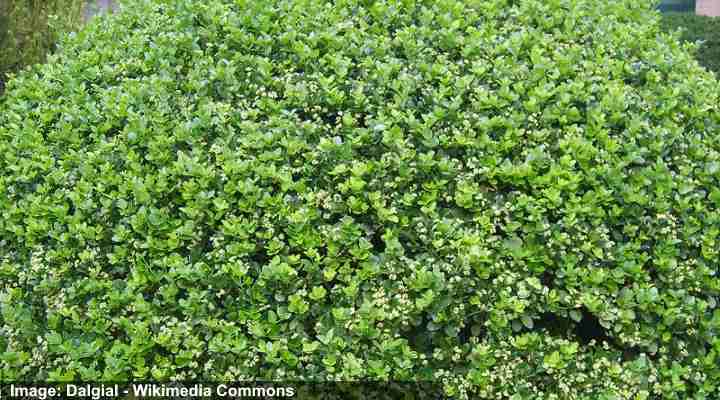
The dense foliage of Japanese spindle masks it an excellent plant for privacy hedge
Depending on the climate, Japanese spindle hedges can be evergreen or deciduous. Their yellow and green or white and green variegated dense foliage creates a bright, bushy hedge. These small shrub-like trees only grow a few feet tall, so they are best suited for low ornamental or formal hedges.
You can also grow Japanese spindle plants as ground cover for full sun, edging plants, or climbers up a wall or fence.
Canadian Hemlock (Tsuga canadensis)
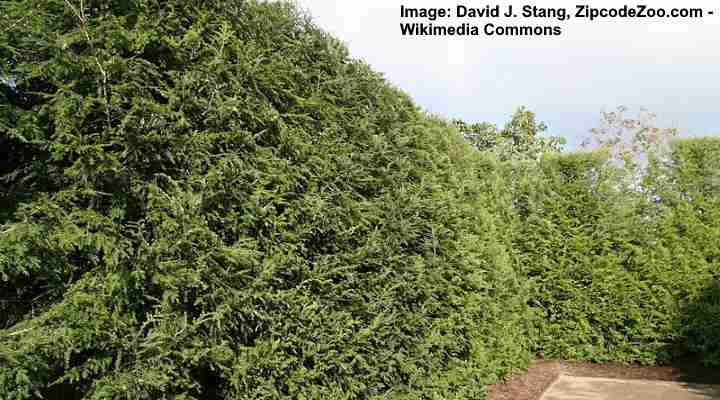
Canadian Hemlock creates fast growing dense living fence
Canadian hemlock trees are plants that love the shade but will also grow well in full sun. When planted together in a row, these impressive trees can create a privacy screen due to their dense growth. With the correct trimming, you can train the evergreen trees to grow as a magnificent formal hedge.
Juniper Hedge Plants (Juniperus)
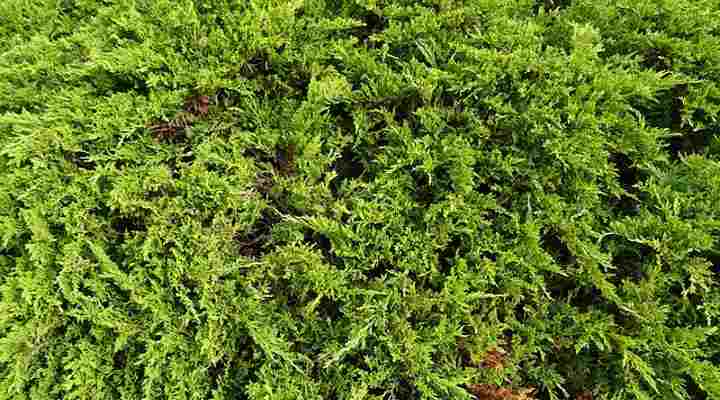
Some cultivars of junipers are low growing and can be pruned to create evergreen hedge fence
Many medium-sized and low-growing junipers are excellent for creating living privacy screens. Most juniper trees have needle-like leaves that can be prickly to handle. When growing together in a row, the dense foliage creates a natural barrier to block out noise or act as a windbreak.
The Best Deciduous Hedging Plants (With Pictures and Names)
Deciduous hedge bushes and shrubs lose their leaves in the fall and winter. Therefore, they don’t offer the year-long privacy that evergreen hedges provide. However, many homeowners choose deciduous hedges for their ornamental value. Deciduous flowering hedges are more informal than evergreen ones, yet still offer some privacy and protection during winter.
Roses for Hedging Plants
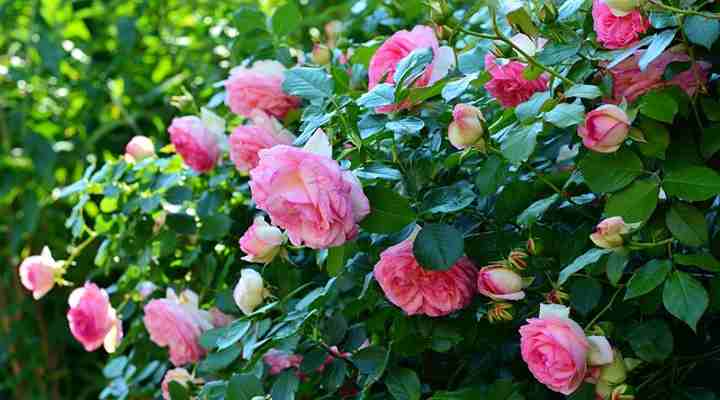
Rose shrubs can create attractive flowering hedge in your garden
Many types of rose plants are perfect for hedging as they have prickly stems, dense spring and summer foliage, beautiful flowers and great scent. You can plant rose hedge bushes along borders to add privacy to your front or back yard.
To encourage bushy growth and create a privacy screen, you need to prune rose bushes during their first year. To create a thicker rose hedge, plant two rows of rose shrubs together.
Glossy Abelia (Abelia × grandiflora)
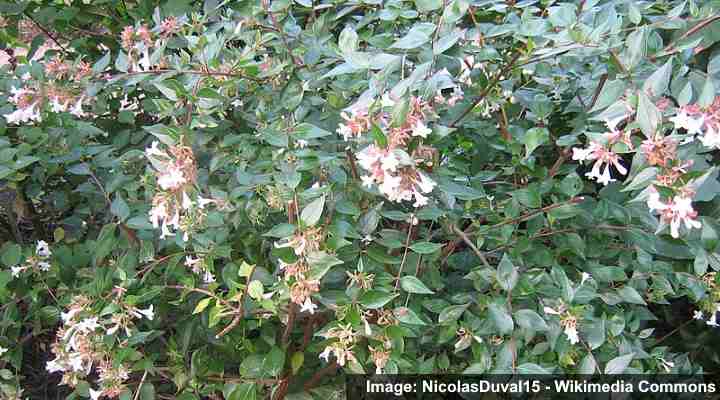
The flowers of glossy abelia add interest and beauty to your hedge or fence line
The densely growing foliage on the glossy abelia makes this medium-sized bush perfect for hedges. This is a semi-evergreen type of hedge that proliferates in full sun. The hedge blooms in late spring until fall with clusters of white, bell-shaped flowers that give off a pleasant scent.
Grow glossy abelia shrubs as an informal hedge in front yards or back yards. They also grow well as a hedge along a fence line or as a single specimen shrub. The hedgerow grows to between 3 and 6 ft. (1 – 1.8 m) tall.
Japanese barberry (Berberis thunbergii)
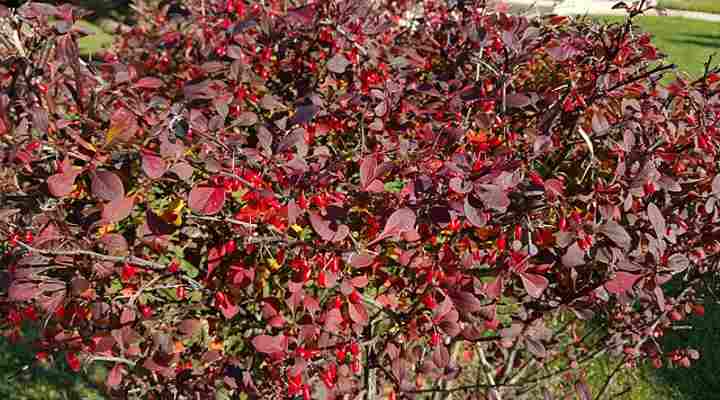
The attractive colorful foliage of the Japanese barberry adds decorative element to your living fence
If you are looking for a low-growing, colorful border hedge, then the Japanese barberry is an excellent choice. Vibrant red, yellow, or violet foliage adds striking colors to a front or back garden. Some Japanese barberry plant cultivars have been specially developed for hedges. There are also cultivars with variegated leaves to create bright informal hedges.
Sweet Mock Orange (Philadelphus coronarius)

The beautiful flowers of sweet mock orange create an ornamental flowering hedge
Also called English dogwood, this deciduous ornamental hedging shrub is ideal for creating an informal hedge in your backyard. The stiff, woody branches have upright growth and produce dark-green, oval leaves and beautiful white flowers. When the hedgerow flowers, it fills gardens with fragrant summer scents.
You can grow sweet mock orange shrubs as a border hedge or a summer privacy screen in backyards. As a standalone specimen plant, the shrub can grace front yards. The bushy shrub grows to between 10 and 12 ft. (3 – 3.6 m) tall.
Hedge Maple (Acer campestre)
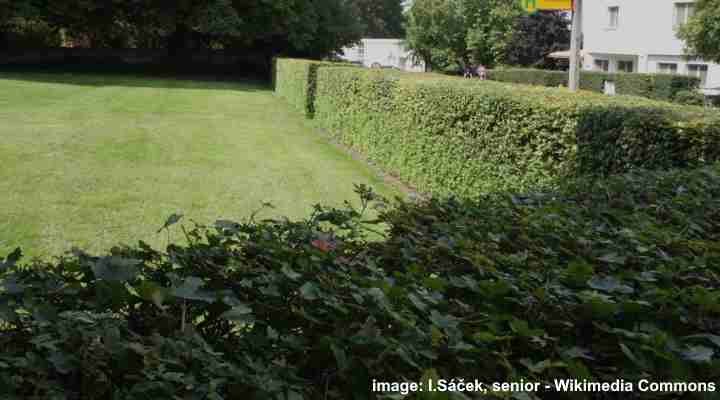
Choose maple for a fast growing hedge with yellow foliage in autumn
Also called the field maple hedge, this deciduous tree has dense, broadleaf growth to create an impressive formal hedge. The fast-growing hedging plant grows to a medium size to create boxed-hedgerows between 3 and 16 ft. (1 – 5 m) tall. During the spring and summer, hedge maples are superb privacy screens. Their foliage then turns a spectacular bright yellow color before dropping.
Rock Cotoneaster (Cotoneaster horizontalis)
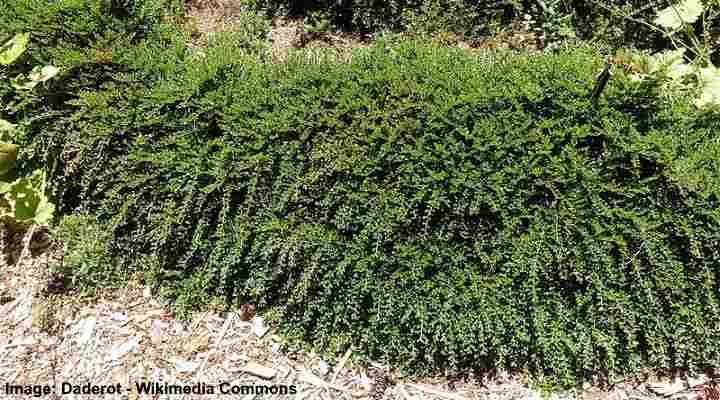
In the picture: Cotoneaster horizontalis var. perpusillus
As its scientific name suggests, this deciduous shrub has a horizontal spreading growth habit. The flowering bush has dense growth that makes an excellent low-growing hedgerow or short screen. This type of hedge is perfect for low-maintenance border hedges, where high growth isn’t necessary.
Rock cotoneaster grows to between 2 and 3 ft. (0.6 – 1 m). You can expect small white flowers in late spring that are followed by bright red berries in fall.
Korean Lilac (Syringa meyeri)
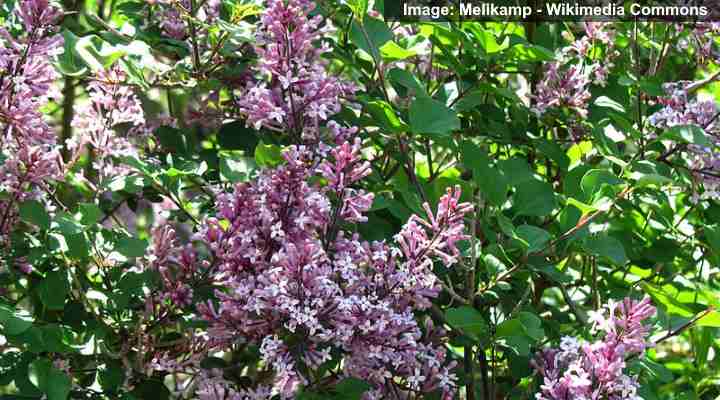
Korean lilac is an excellent flowering hedge plant with colorful foliage in the fall
Lilac tends to be a sizeable spreading bush. However, the Korean lilac is a compact shrub in the genus Syringa that is ideal as a hedging plant. The hedge bush produces an abundance of lilac flowers that contrast with the dark green leaves. In the fall, Korean lilac foliage turns a spectacular reddish-bronze that adds color to autumn garden landscapes.
Grow Korean lilac in backyards as an informal flowering hedge or trim into a dramatic formal hedge.
European Beech (Fagus sylvatica)
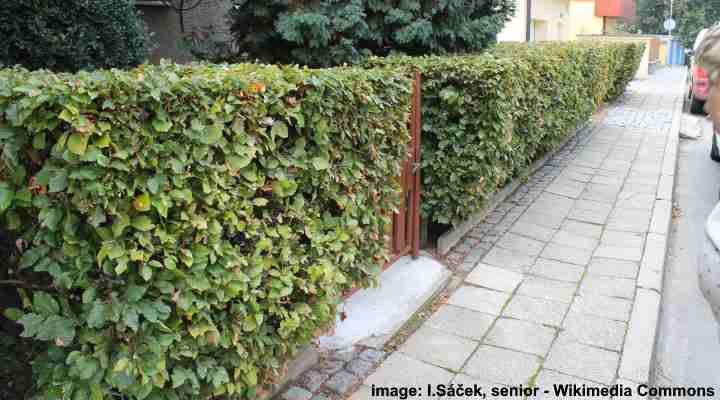
European beech can be pruned to adjust the hedge to the desired height
One of the most popular deciduous hedging plants is the European beech. This plant can be clipped as a hedge to create attractive privacy screens—even in winter. Because the European beech is a large tree, extensive pruning is needed to create a formal hedge. However, you can create a stunning formal hedge in any shape you desire.
The leafy hedge has dark green foliage that changes to various colors throughout the season. Even though the European beech is a deciduous hedge, it keeps its bronze leaves throughout winter. So this shrubby plant also acts as a privacy screen in the winter months.
Arrowwood Viburnum (Viburnum dentatum)
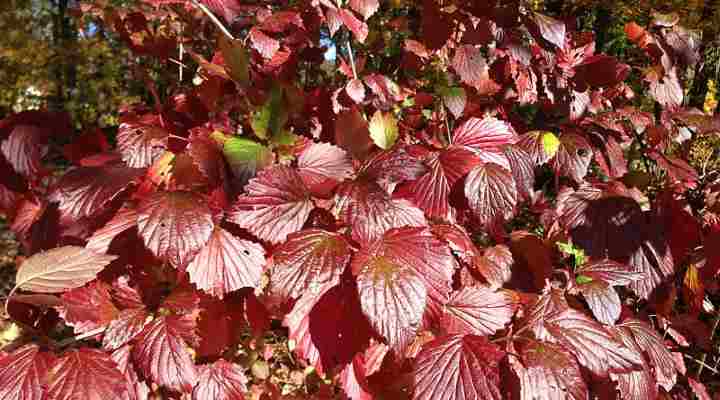
Grow arrowwood viburnum hedging plants for their beautiful red foliage in autumn
This small shrub is another hedging plant that is excellent for creating summer privacy screens. One of the best arrowwood cultivars is the ‘Blue Muffin.’ The shiny green foliage contrasts with clusters of white flowers in the summer, and then blue berries appear in late summer and fall.
Grow arrowwood plants as attractive border shrubs, flowering hedges, or privacy screens.
Common Hornbeam (Carpinus betulus)
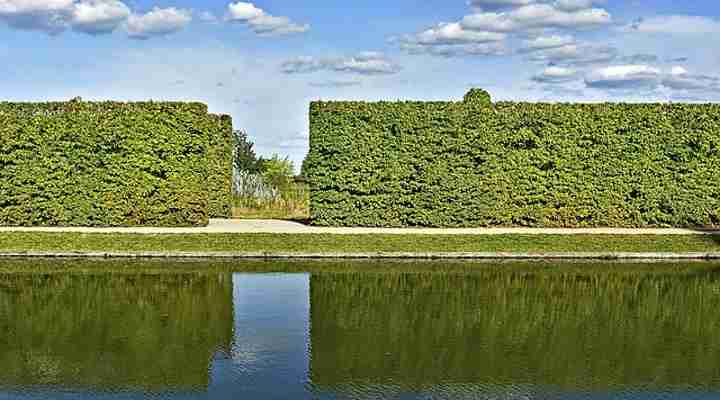
The fast growing Hornbeam can be pruned to create a formal dense privacy hedge
If you are looking for a tall ornamental hedge, then the common hornbeam is an excellent choice. The hornbeam tree is a member of the birch family and is common in garden landscapes. This hedging tree has average growth and when in full foliage, creates an excellent privacy screen. The best height for growing Carpinus betulus as an easy-to-care-for hedge is between 3 and 16 ft. (1 – 5 m).
Hornbeam hedges are similar to beech hedging as they have copper-colored leaves in the fall. Even though this is a deciduous hedge, it still provides protection from wind, noise, and intruders in the winter.
Spirea Backyard Hedges
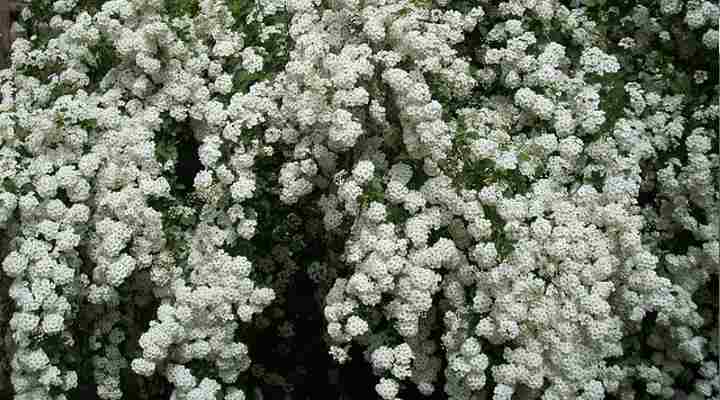
The stunning blooms of spirea create an attractive and low maintenance hedge
Most shrubs in the genus Spiraea are great hedging plants that are easy to care for. The hedges are bright and colorful due to the orange, red, and yellow foliage. However, it’s not just the foliage that makes this border hedge attractive; beautiful sprays of flower clusters appear on the hedge in summer.
Plant as a low-growing hedge up to 4 ft. (1.2 m) tall or plant as a specimen tree in a front yard to boost the aesthetics of your property. These border hedges thrive in full sun.
Forsythia
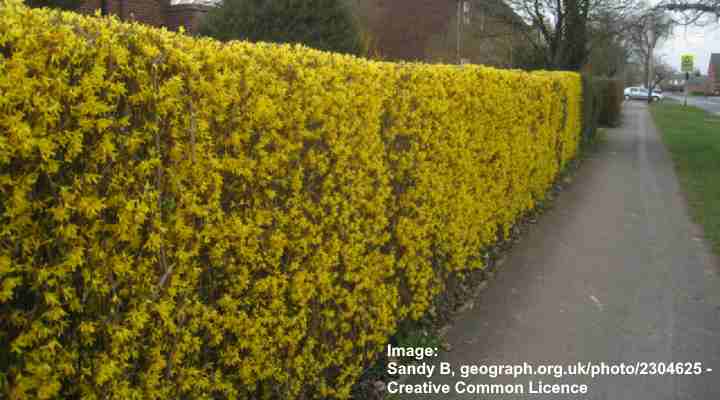
Forsythia is a hardy shrub that makes a good choice for fast-growing flowering hedge
Plants from this species of medium-sized deciduous shrubs create delightful, bright border hedges. Forsythia hedges are attractive in backyards because of their colorful yellow spring flowers that appear before the foliage. You can plant Forsythia shrubs as a flowering hedge, mixed border, or specimen plant.
Depending on the cultivar, these hedging bushes grow to between 2 and 10 ft. (0.6 – 3 m). To create a year-long flowering privacy screen, grow Forsythia shrubs with other hedging plants.
Hydrangea Hedge Plants
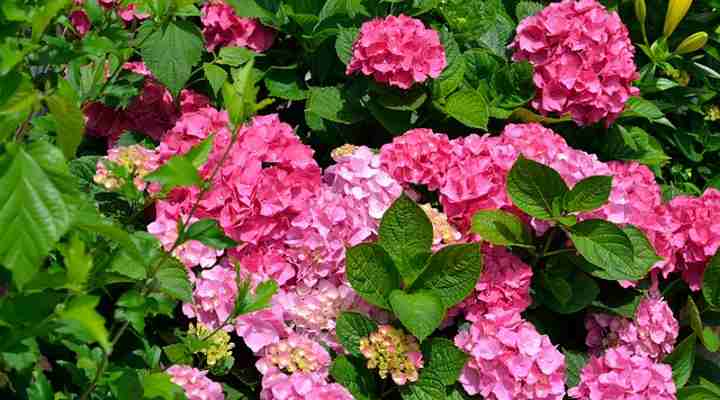
Hydrangea varieties can create an informal flowering hedge and are easy to care for
Some of the most stunning types of informal flowering shrubs for making hedges are hydrangeas. The round hydrangea bushes produce large globular or cone-shaped clusters of flowers. Growing as a flowering hedge, they provide plenty of privacy while filling your garden with color and fragrance in the summer.
Hydrangeas are stunning flowering hedgerow plants that come in many species. Choose from bushy hedges that have blue, lilac, white, or pink dome-shaped flowerheads. Or pick other shrubs that have flowers in the shape of cones in various pastel shades.
Flowering Quince Hedges (Chaenomeles)
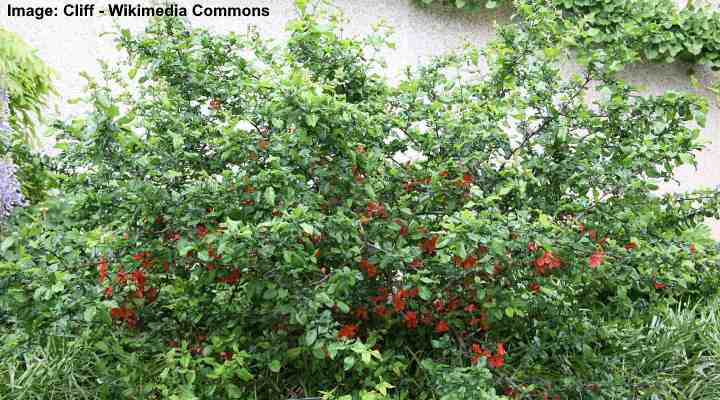
In this image: Chaenomeles x superba “Mandarin”
Quince flowering shrubs are excellent plants for informal hedges or colorful borders. Quinces bushes from the species Chaenomeles japonica and Chaenomeles x superba don’t grow more than 4 ft. (1.2 m) high. The flowering hedges start blooming with colorful, fragrant flowers from late winter until early spring.
Due to their thorny branches, quince hedges are also great security barriers in your yard. Alternatively, you can plant quince shrubs as a border plant or a standalone specimen plant in your front or backyard.
Rose of Sharon (Hibiscus syriacus) Hedge Bushes
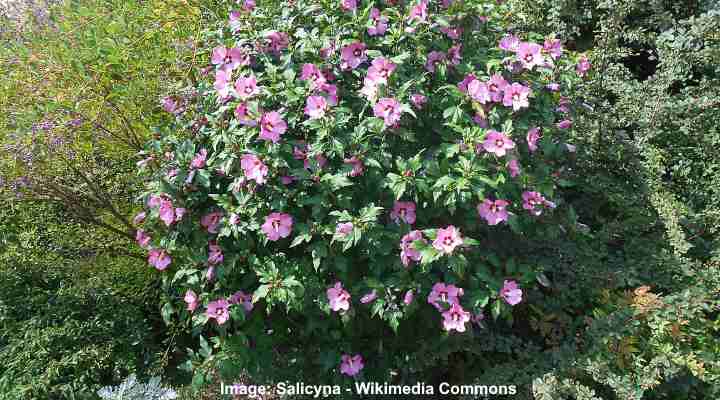
The ability to shape rose of Sharon shrub makes it a good choice for flowering hedges
The Rose of Sharon is one of the most stunning plants to use as a flowering hedge in a backyard. Without trimming, they grow to between 8 and 12 ft. (2.4 – 3.6 m) tall, but you can train the beautiful shrub to stay around 5 ft. (1.5 m) as a pretty hedge. When in full bloom, the bushy hedge produces large, showy, trumpet-shaped flowers.
Plant Rose of Sharon bushes in a row to create a beautiful privacy screen or regularly trim if you want a formal hedge.
Related articles:
